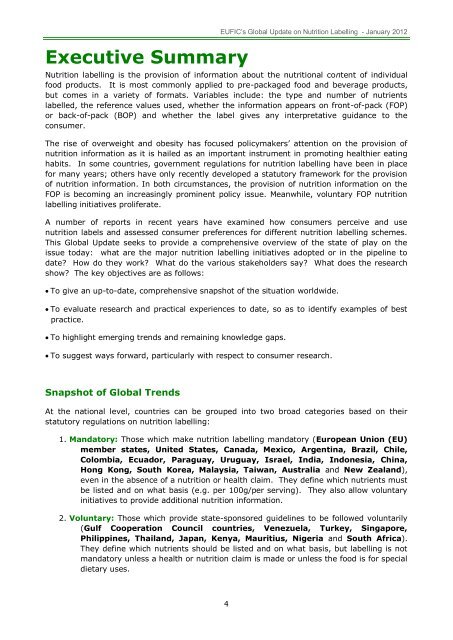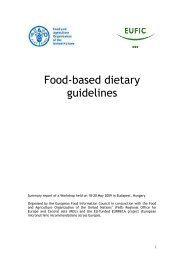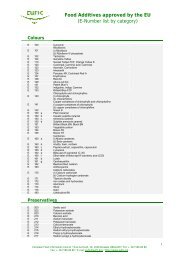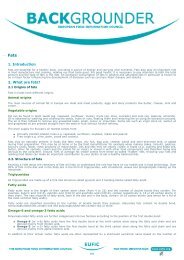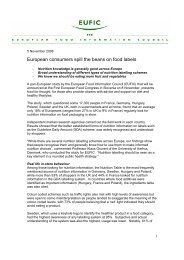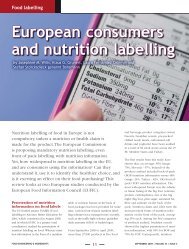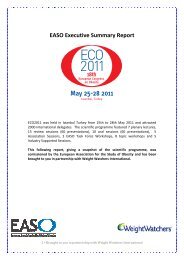Global Update on Nutrition Labelling - The European Food ...
Global Update on Nutrition Labelling - The European Food ...
Global Update on Nutrition Labelling - The European Food ...
Create successful ePaper yourself
Turn your PDF publications into a flip-book with our unique Google optimized e-Paper software.
Executive Summary<br />
EUFIC’s <str<strong>on</strong>g>Global</str<strong>on</strong>g> <str<strong>on</strong>g>Update</str<strong>on</strong>g> <strong>on</strong> Nutriti<strong>on</strong> <strong>Labelling</strong> - January 2012<br />
Nutriti<strong>on</strong> labelling is the provisi<strong>on</strong> of informati<strong>on</strong> about the nutriti<strong>on</strong>al c<strong>on</strong>tent of individual<br />
food products. It is most comm<strong>on</strong>ly applied to pre-packaged food and beverage products,<br />
but comes in a variety of formats. Variables include: the type and number of nutrients<br />
labelled, the reference values used, whether the informati<strong>on</strong> appears <strong>on</strong> fr<strong>on</strong>t-of-pack (FOP)<br />
or back-of-pack (BOP) and whether the label gives any interpretative guidance to the<br />
c<strong>on</strong>sumer.<br />
<strong>The</strong> rise of overweight and obesity has focused policymakers’ attenti<strong>on</strong> <strong>on</strong> the provisi<strong>on</strong> of<br />
nutriti<strong>on</strong> informati<strong>on</strong> as it is hailed as an important instrument in promoting healthier eating<br />
habits. In some countries, government regulati<strong>on</strong>s for nutriti<strong>on</strong> labelling have been in place<br />
for many years; others have <strong>on</strong>ly recently developed a statutory framework for the provisi<strong>on</strong><br />
of nutriti<strong>on</strong> informati<strong>on</strong>. In both circumstances, the provisi<strong>on</strong> of nutriti<strong>on</strong> informati<strong>on</strong> <strong>on</strong> the<br />
FOP is becoming an increasingly prominent policy issue. Meanwhile, voluntary FOP nutriti<strong>on</strong><br />
labelling initiatives proliferate.<br />
A number of reports in recent years have examined how c<strong>on</strong>sumers perceive and use<br />
nutriti<strong>on</strong> labels and assessed c<strong>on</strong>sumer preferences for different nutriti<strong>on</strong> labelling schemes.<br />
This <str<strong>on</strong>g>Global</str<strong>on</strong>g> <str<strong>on</strong>g>Update</str<strong>on</strong>g> seeks to provide a comprehensive overview of the state of play <strong>on</strong> the<br />
issue today: what are the major nutriti<strong>on</strong> labelling initiatives adopted or in the pipeline to<br />
date? How do they work? What do the various stakeholders say? What does the research<br />
show? <strong>The</strong> key objectives are as follows:<br />
To give an up-to-date, comprehensive snapshot of the situati<strong>on</strong> worldwide.<br />
To evaluate research and practical experiences to date, so as to identify examples of best<br />
practice.<br />
To highlight emerging trends and remaining knowledge gaps.<br />
To suggest ways forward, particularly with respect to c<strong>on</strong>sumer research.<br />
Snapshot of <str<strong>on</strong>g>Global</str<strong>on</strong>g> Trends<br />
At the nati<strong>on</strong>al level, countries can be grouped into two broad categories based <strong>on</strong> their<br />
statutory regulati<strong>on</strong>s <strong>on</strong> nutriti<strong>on</strong> labelling:<br />
1. Mandatory: Those which make nutriti<strong>on</strong> labelling mandatory (<strong>European</strong> Uni<strong>on</strong> (EU)<br />
member states, United States, Canada, Mexico, Argentina, Brazil, Chile,<br />
Colombia, Ecuador, Paraguay, Uruguay, Israel, India, Ind<strong>on</strong>esia, China,<br />
H<strong>on</strong>g K<strong>on</strong>g, South Korea, Malaysia, Taiwan, Australia and New Zealand),<br />
even in the absence of a nutriti<strong>on</strong> or health claim. <strong>The</strong>y define which nutrients must<br />
be listed and <strong>on</strong> what basis (e.g. per 100g/per serving). <strong>The</strong>y also allow voluntary<br />
initiatives to provide additi<strong>on</strong>al nutriti<strong>on</strong> informati<strong>on</strong>.<br />
2. Voluntary: Those which provide state-sp<strong>on</strong>sored guidelines to be followed voluntarily<br />
(Gulf Cooperati<strong>on</strong> Council countries, Venezuela, Turkey, Singapore,<br />
Philippines, Thailand, Japan, Kenya, Mauritius, Nigeria and South Africa).<br />
<strong>The</strong>y define which nutrients should be listed and <strong>on</strong> what basis, but labelling is not<br />
mandatory unless a health or nutriti<strong>on</strong> claim is made or unless the food is for special<br />
dietary uses.<br />
4


